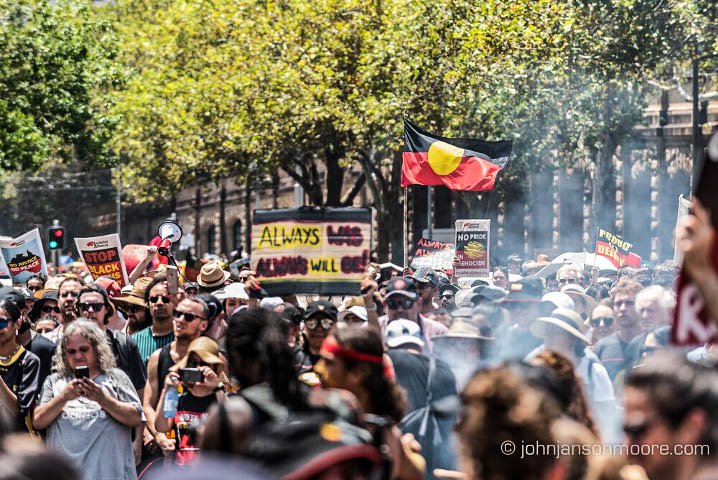Source analysis
-
Audience
Secondary school -
Learning stage
Stage 4, Stage 5, Stage 6 -
Learning area
First Nations, History -
Type
Teaching resources
On this page...
Australia’s true foundation story is more than the voyage of James Cook or the arrival of the First Fleet. It is a story about the seizure of land from First Nations peoples, denial of Indigenous sovereignty, devastating frontier wars, and separation from families and homelands. This history is important to understand as we live in a legacy of this past. This privileges some but disadvantages others. Recognising this shared past is an important part of our journey towards a shared future.
We can only recognise our shared past if we look honestly and critically at the sources that shape our understanding of history. In this activity, you will be presented with a range of historical sources from the exhibition Unsettled and from the Australian Museum collections. You will need to answer the guiding questions for each source to help you work like a historian and uncover the evidence within.
You may work in groups or individually. If you work individually, make sure you discuss your responses and understanding together afterwards.
- Sometimes we take things for granted in our history without checking the sources. According to market research commissioned by the Federal Government for the 2020 Cook anniversary, 47% of Australians incorrectly think that Cook and the Endeavour arrived with the First Fleet in 1788. Poll your friends and family – what is their understanding?
- Historians need to compare evidence from different sources and perspectives to assess reliability. For example, Lieutenant Cook noted in his journal that on 22 August 1770 he landed on Tuined (an island in the Torres Strait), raised the First Union flag and claimed possession of the land for Great Britain. However, other diarists onboard the HMB Endeavour, did not note an annexation ceremony during their passage through the Torres Strait. There is some speculation that the event was added into the records later.
There are lots of elements we need to remember when analysing a historical source. You can use these guiding questions to unpack primary and secondary sources and gather evidence for a historical argument.
- Is it a primary or secondary source? When was the source created and who created it?
- Why was this source created? What is the content of the source? Who was the intended audience?
- What is the perspective presented in this source? Are there certain opinions or beliefs that it presents? Why do you think the source is presented in this way?
- How reliable is it as a historical source? Are there other sources that back up the evidence presented in the source?
- How useful is it as a historical source? Does it help us understand the historical context?
Ask your students to select a pair of sources from the list below. Some correspond to images on this page, some are excerpts from longer texts or recordings and some are links to other institutions and libraries that hold those sources in their collection.
Respond to each of the two sources using the source analysis guiding questions above.
Sources
- Aborigines Day of Mourning, 1938. Reproduction of a 1938 newspaper clipping. Image courtesy of the State Library of New South Wales.
- Invasion Day Protest in Sydney, 2020. Photo: John Janson-Moore. (see image below)

- Cook Falling, Tear it Down, Graphic Novel Study, 2019. Travis de Vries. Digital print on archrival paper. Australian Museum Collection Acquisition. (see image below)
- Photo of Captain Cook statue in Hyde Park with red paint graffiti, Sydney. Graffitied on 25 January, 2017. Photo: Megan Lawrence. (see image below)
- Dhari, 1907. Made by Ancestor. Torres Strait Pigeon feathers, bamboo frame, fibre, wool, Kolap (Goa nut). Australian Museum Collection. (see image below)
- Kitten, Chief of Sydney Tribe Breastplate, date unknown. Maker Unknown. (see image below)
- Wailwan Grindstone (fragment), c 30,000 years old. Made by Ancestor. Sandstone. Australian Museum Collection. (see image below)
- Secret Instructions for Lieutenant James Cook, Appointed to Command His Majesty's Bark the Endeavour, 1768. Courtesy of the National Library of Australia.
- Captain Cook Taking possession of the Australian Continent on Behalf of the British Crown, AD 1770. Under the Name of New South Wales. Samuel Calvert. Drawn and engraved by Samuel Calvert from the great historical painting by Gilfillan in the possession of the Royal Society of Victoria. Courtesy of the National Library of Australia.
- Excerpt from Sovereignty, False Pretences Without the Rightful Consent, 2020. Interview with Elder Waubin Richard Aken, Appointed Tribal Historian talks about the HMB Endeavour voyage.
"Days before Cook's arrival, smoke signals which we call blackfella internet, notified all the clan groups of Cape York that a strange ship's travelling along the East Coast. Our warriors were waiting patiently for him, camouflaged in surrounding islands, ready to attack. But the signal never came form our Kuiku mabiag. Why? Because he never walked on the land. If he did, we wouldn't have British sovereignty in Australia today. How can you claim sovereignty from a captains ship logbook whilst floating in the water?"









